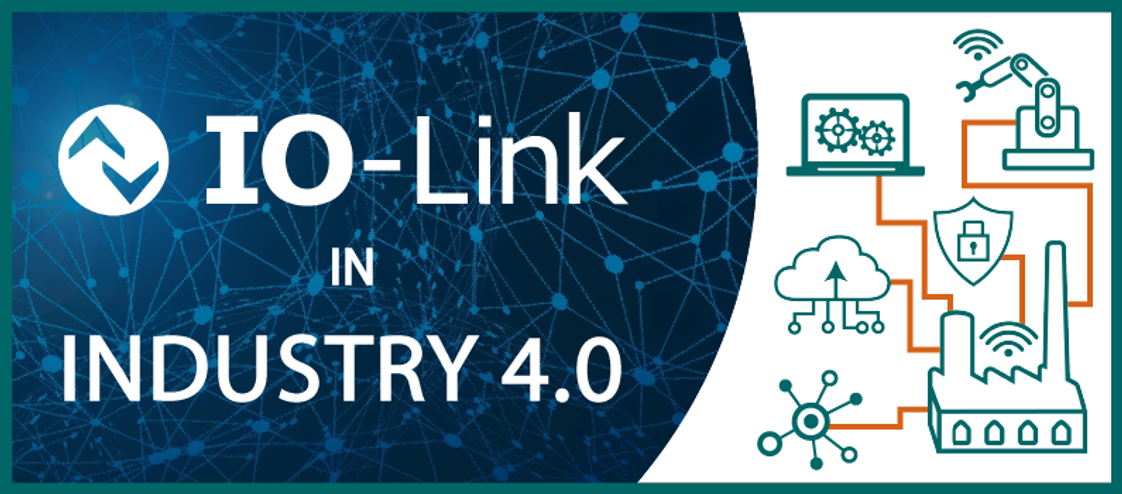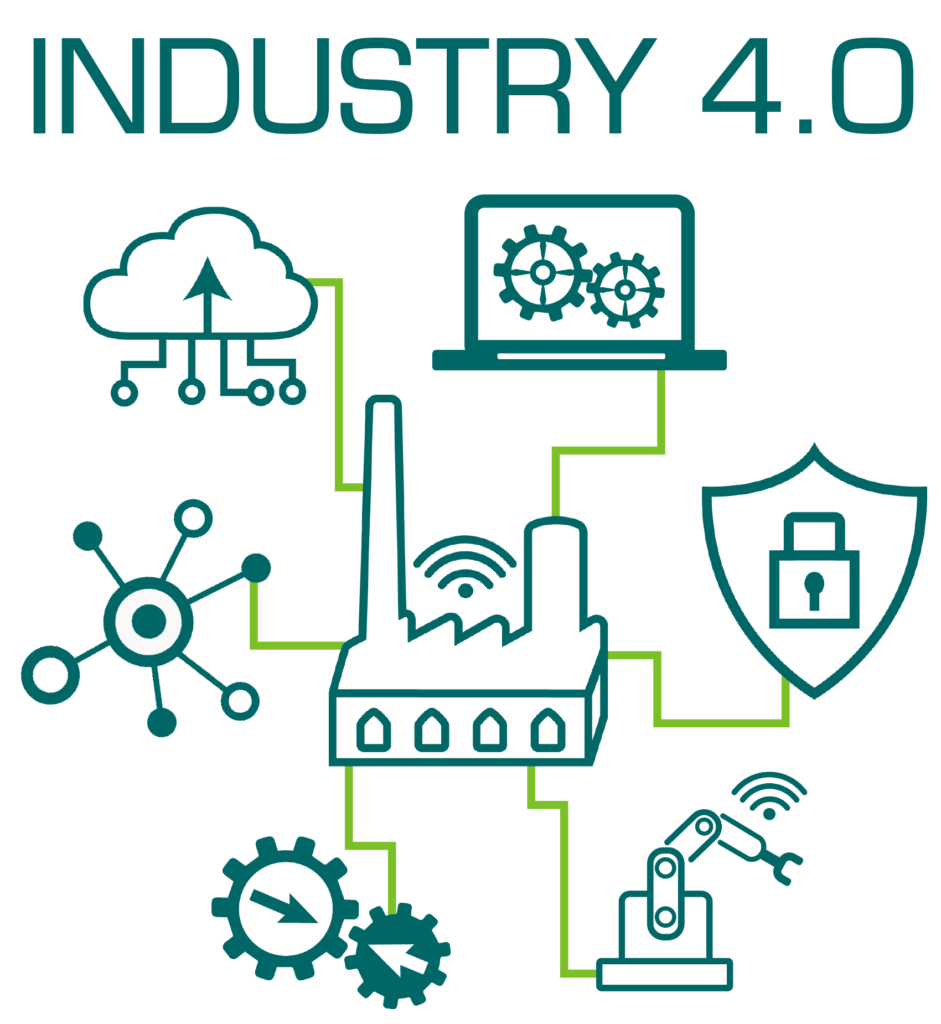
What does IO-Link mean in Smart Manufacturing?
Posted by Morgan Spano on Jul 25th 2022
We’ve all heard of the industrial revolution, but have you heard of Industry 4.0?
We’ve entered the fourth revolution in automation technology and IO-Link is at the forefront. Since 2006, when the term “Smart Manufacturing” was first coined, industrial manufacturers have been focused on improving the transmission and analysis of production data.

Image courtesy of Jeff Winter and ISA Interchange.

Knowing exactly what’s happening on your manufacturing floor can mean major improvements in production efficiency and worker safety.
Smart factories incorporate products, such as sensors and actuators, to receive real-time data and easily adjust parameters, which reduces unnecessary downtime.
It’s important to note that in order to connect to these devices, you’ll need to incorporate a communication protocol.
IO-Link
As the world’s first standardized IO technology for communicating with sensors and actuators, IO-Link was designed for fast and easy data transmission. This bi-directional, digital, point-to-point industrial networking protocol allows for users to directly interface with multiple sensors and actuators via higher-level controllers.
What makes IO-Link stand out is the capability to transmit three types of data cyclically or acyclically: process data, service data and event data.
What kind of technology is implemented in Industry 4.0?
- Industrial Internet of Things (IIoT)
- Smart machines and collaborative robotics
- Cloud and edge computing
- Additive manufacturing (AM)
- Advanced robotics
- Augmented and virtual reality (AR/VR)
Process Data
This input or output data shows the latest state of the sensor, or communicates the desired state of the actuator. It is communicated every communication cycle (usually around 2 ms) and can contain between 1 bit and 32 bytes of information.
Service Data
Service Protocol Data Units (SPDUs) allow the user to retrieve detailed information about the device. Communicated using up to sixteen thousand blocks, it can convey everything from basic device information (e.g. versions, type, serial numbers, etc.) to much more advanced information (e.g. configuration, detailed diagnostics or status). Some parts of the information are standard to the protocol, but device manufacturers can make available any necessary information or configuration.
Event Data
Events which occur too rarely to be included in the process data, but should be reported without waiting for an SPDU to be queried can be delivered using IO-Link’s event facility. This allows standard or vendor specific information about any alarms or informational messages to be delivered as they are encountered.
Learn more about Comtrol Pepperl+Fuchs IO-Link technology here
How IO-Link Works
An IO-Link system uses a master-slave connection to interface with multiple sensors or actuators via M12, M8, or M5 ports and unshielded 3-wire cabling. By using the IO-Link Master as a central hub, sensors and actuators are able to transmit a wealth of data including diagnostics, operational data and signal quality to higher level devices such as HMIs, computers, tablets, and PLCs.
Companies, such as Pepperl+Fuchs, have joined the IO-Link Consortium in order to produce equipment with unified features making networking easy.
IO-Link Features:
- Bidirectional, serial point-to-point connectivity for signal and power
- Modes of operation: Standard IO mode (SIO), IO-Link mode
- Three transfer rates: 4.8 kBaud (COM 1), 38.4 kBaud (COM 2), 230.4 kbaud (COM 3)
- Unshielded industry-standard cabling
- Pin assignment: Pin 1: 24 V, Pin 3: 0, Pin 4:
- Switching and communication line (C/Q)
- Cable length: 20 m maximum
What Kind of Products are Able to Connect to IO-Link:
- Photoelectric sensors
- Ultrasonic sensors
- Inductive proximity sensors
- Positioning systems
- RFID
- In addition to IO-Link sensors, I/O hubs with IO-Link
The next industrial revolution is here and it’s all about making your production smarter. Contact Marshall Wolf Automation today to find your next IO-Link product.
Common Terms Used in Industry 4.0
- DeviceNet: An industrial, digital, multi-drop fieldbus network protocol used to interconnect control devices for data exchange. Commonly used with industrial controllers, PLCs, actuators, sensors, and automation systems of multi-vendors.
- EtherNet/IP: An industrial network protocol that adapts the Common Industrial Protocol (CIP) to standard Ethernet.
- Fieldbus: A family of industrial computer networks used for real-time distributed control. These networks are standardized by the International Electrotechnical Commission (IEC) as IEC 61784/61158
- IO Device: An input/output device is any hardware used by a human operator or other systems to communicate with a computer.
- IIoT (Industrial Internet of Things): The incorporation of smart machines and real-time analytics to network multiple industrial devices through communication technology. This networking allows for system-wide monitoring, data collection and the deliver valuable insights for production and machine maintenance. IIoT incorporates information technology (IT) and operational technology (OT), such as human machine interfaces (HMIs), supervisory control and data acquisition (SCADA) systems, distributed control systems (DCSs), and programmable logic controllers (PLCs), optimizing automation.
- Learn more about IIoT at Trend Micro
- Industry 4.0: In reference to the four industrial revolutions beginning in the 18th century, Industry 4.0 was coined first in Germany and then by the World Economic Forum as the “widespread integration of information and communication technology in industrial production.” This includes the use of IoT (Internet of Things), autonomous systems, cloud computing analytics and machine learning to optimize automation.
- Learn more about Industry 4.0 here
- IO-Link: An industrial point-to-point serial communication protocol used to communicate with sensors and/or actuators. IO-Link allows for three types of data to be exchanged: process data, service data, and events.
- MODBUS: a serial communication protocol used to transmit data over serial lines between electronic devices, namely programmable logic controllers (PLCs). The device requesting the information is called the Modbus Master and the devices supplying information are Modbus Slaves. In a standard Modbus network, there is one Master and up to 247 Slaves, each with a unique Slave Address from 1 to 247. The Master can also write information to the Slaves.
- Read more about MODBUS here
- PROFIBUS (Process Field Bus): One of the most widely used fieldbus communication industrial control networks for industrial process control, motion control, automation, and safety networks. PROFIBUS uses a unidirectional master-slave communication in between the components of the control network.
- PROFINET: An internationally established industrial Ethernet communication protocol designed to exchange data between controllers and devices in an automation setting, This protocol uses cyclic and acyclic communication between components; including diagnostics, functional safety, alarms, and additional information.
- Learn more about ProfiNet here
- Service Protocol Data Units (SPDUs): Units of information transmitted within a network which allows the user to retrieve detailed information about the connected device. Communicated using up to sixteen thousand blocks, it can convey simple information such as versions, type, serial numbers and even more advanced information like configuration, detailed diagnostics or status.
- Smart Manufacturing: Originating in 2006 at a National Science Foundation workshop on Cyberinfrastructure; a “smart plant” composed of ‘smart assets’ that not only provide their basic process function but provide proactive feedback on the economic, environment, health and safety performance of that asset in aggregation with the other assets and in the moment. A fully-integrated, collaborative manufacturing system that responds in real time to meet changing demands and conditions in the factory, in the supply network, and in the customer needs.
